Your vision is important to us.
Let's see what we can do for you.
What is a cataract?

A cataract is the clouding of the lens inside your eye that can impair vision – anywhere from mildly to severely. Most commonly, cataracts are a result of ageing. From age 50 onwards, there is an ever increasing risk of cataract occuring, independently in either one or both eyes. Around age 60, cataract becomes a "standard risk" that needs to be reckoned with. By age 80, more than half of the population either have a cataract or have had cataract surgery. Cataract is also the principal cause of blindness in the world.
How do I notice a cataract?

Cataract clouds the lens and reduces the light that reaches the retina. It spreads light instead of focusing it, causing haloes around stronger light sources such as lights of oncoming cars at night. While a cataract is still small, the cloudiness affects only a small part of the lens, and you may not notice any changes in your vision at first. Cataracts tend to progress slowly, thus vision and blurring only get worse gradually. Over time, as the cloudy area in the lens gets larger and the cataract increases in size, seeing can become very difficult. You may also notice some discoloring of your vision; it can obtain a brownish to yellowish tint. With advancing lens discoloration, you may not be able to clearly distinguish blues and purples anymore.
What causes cataracts?
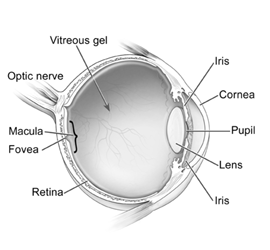
The lens lies behind the iris and the pupil. It works much like a camera lens, by focusing light onto the retina at the back of the eye. It also adjusts the eye’s focus, letting us see things clearly both up close and far away. The lens is made of mostly water and protein. The protein is arranged in a precise way that keeps the lens clear and lets light pass through it.
As we age, some of the protein may clump together and start to cloud a small area of the lens – this is a cataract. Over time, the cataract can grow larger and cloud more of the lens. The protein in the lens changes from the wear and tear it takes over the years. While there is no single direct cause, researchers have identified a number of factors that are associated with cataract, such as UV light, diabetes, hypertension, smoking, family history, previous eye injury, excessive alcohol intake and more.
What treatment options are there?

When cataract symptoms begin to appear, you may be able to improve your vision for a while using new glasses, strong bifocals, magnification, appropriate lighting or other visual aids. But those are merely temporary measures to alleviate the symptoms, and will neither stop nor slow down a cataract's progress.

When the visual impairment reaches a point where it negatively affects the quality of life, or becomes outright dangerous (e.g. driving, especially at night), the time has come to think about cataract surgery. Many people consider poor vision an inevitable fact of ageing. But there's no good reason to resign: cataract surgery is a simple, quick and almost entirely painless procedure to regain proper vision, and to almost instantly improve the quality of life by a large measure!
Cataract surgery - step by step.
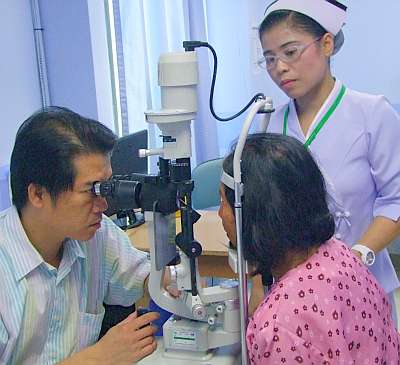
Surgery is preceded by an extensive series of laboratory and visual tests. We use detailed questionaires to assess patients current health status and medication history, in order to eliminate potential complications. Highly advanced technology helps us verify the viability and safety of the pending surgery. The combination of tests provide our specialists with all necessary data to preclude complications, and to choose the optimal foldable IOL (intra-ocular lens) and its correction factor. The testing does take a while, but is completely painless. To gain perfect insight into a patients eye, it needs to be dilated with medical eye drops, which can cause slight visual discomfort. We therefore provide wheel chairs with a helper person for our patients safety and comfort.
By the time all tests are done and have indicated that there are no risks in going forward, patients are taken to the pre-surgery area, where medical eye drops are given in several intervals. This process is again painless, but takes some time and patience – the eye needs to be conditioned properly for surgery. The eye drops contain medication that almost completely eliminates sensitivity for pain, thus doing away with the need for any anestetics – no injections are necessary.
During surgery, the patient's head is situated in a special "cushion" to immobilize it. The surgery, which only takes a few minutes, starts with a very small incision, through which the clouded lens is broken up using ultrasound ("phacoemulsification"). The fragments are then carefully removed by suction.
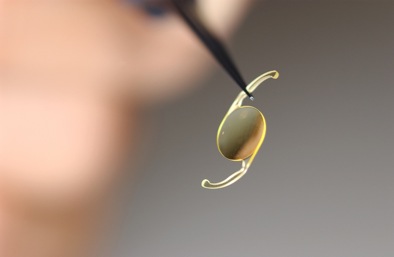
Subsequently, the foldable IOL (intra-ocular lens) is inserted and secured in place. And that's it already – the surgery is completed in less time than it takes to drink a hot cup of coffee!
Post-surgery, the eye is covered with a padded plastic "cup" to let it recover and to protect it from risk of infections and touching/rubbing during sleep. You spend a comfortable night in your hospital bed.
Welcome back to clear sight!
The next morning, you are taken to the testing area, where the plastic cup is removed and the area around the eye is thoroughly cleaned. At that point,
you will experience a moment of great joy: your eye, previously impacted by blurred and discolored sight, can now see clearly again – without the need of glasses!

It may be slightly sore and irritated for a while, similar to having dust in it, but we provide eye drops to help the healing process and to eliminate the potential for infections. For the following nights, we recommend that you wear the eye patch that we provide during sleep. We also provide a pair of large sunglasses that can be worn over normal glasses, to protect the eye and shield it from a temporary higher light sensitivity. And then: it's time to wrap it up and leave the hospital!
What's next?
A week after the operation, you have an appointment with our specialists: they would like to check the progress of the healing and the eye's general condition. A short but thorough inspection is all it takes. On the odd chance that any irregularities show up, the specialist will be able to take the appropriate steps. Another final check will be scheduled for a month after surgery – we want to make sure that everything is in long-term perfect order.
The thing with old and new glasses.
You were in all probability wearing glasses before the surgery. You will now need to see your optician to replace the lens in front of your "new" eye with a neutral, non-correcting one. An alternative – which in fact might be a better solution – is to opt for a contact lens for the untreated eye.
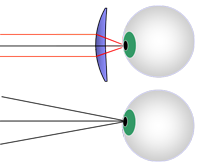
There is a good reason for that: the "new" eye uses the replacement IOL to focus, whereas the lens in front of the untreated eye pre-adjusts that eye's focus at a distance from the eye. With a correcting lens in front of both eyes, tilting your head alters the pre-focus of both eyes equally. But one eye
without, and the untreated eye
with a pre-focusing lens in front of it, tilting your head results in focus at different angles and creates a "double", combined image (parallax shift). Using a contact lens for the untreated eye levels the playing field and eliminates the "double" image, because both eyes again focus in the same manner. Your optician will be able to demonstrate and explain the difference and advise you on your options.
What about reading glasses?
The intra-ocular lenses (IOL) we use are monofocal and help you see items from roughly one meter to infinity sharp and clear. But: they don't make any correction for the close (reading) distance. If you needed reading glasses
before the surgery, you will need reading glasses
after the surgery as well, albeit with a different strength. Your optician will measure your "new" eye and determine the necessary degree of correction. Your "new" eye requires 2-3 weeks to fully stabilize; we recommend that you postpone fitting new reading glasses until that time.
The good news: our package price.
Supamitr-Sena General Hospital is proud to offer a special, very affordable and
complete package at only
THB 25,000, which includes:

• single room with meals, 1 night
• pre-surgery lab and visual tests
• single eye cataract surgery
• post-surgery follow-up tests
• foldable monofocal IOL
• hospital fee
• doctors fee
• nursing fee
• all associated costs for medication and materials
• take-home package including medical eye drops, eye patch, sunglasses, cleaning material and a post-surgery instructions brochure.
Unforeseen events, additional treatments that may unexpectedly arise, and any treatments not related to cataract surgery are not included in this package, and will be charged separately.
Schedule an appointment now!
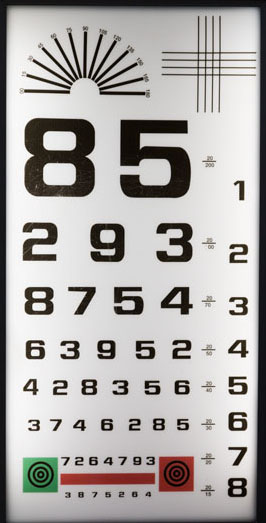
Would you like to make an
appointment for an eye examination, to determine if the time has come for cataract surgery? Or maybe that has already been determined, and you would like to make an
appointment for surgery now?
To schedule an appointment, click
this link (opens in a new window) to send us your details and date preferences online, and we will get back to you with appointment suggestions as soon as possible. The online form also allows you to enter details about your medical background, at your leisure. This will make your registration at the hospital a breeze.
Documents you may find interesting:
For your convenience, we have put together a brochure with suggestions of how to prepare for surgery, and one with guidelines to follow after surgery. These brochures are in .pdf format. Just click on the links to read them online (will open in a new window), or use a right-click and select "Save link as..." to download the brochures to your computer, so that they can be printed. If you are on a mobile / tablet device, tap and hold the link to make a menu pop up, which allows you to save the .pdf to your device.
•
Preparing for cataract surgery
•
Patient's guide after cataract surgery
Search within the website:


 A cataract is the clouding of the lens inside your eye that can impair vision – anywhere from mildly to severely. Most commonly, cataracts are a result of ageing. From age 50 onwards, there is an ever increasing risk of cataract occuring, independently in either one or both eyes. Around age 60, cataract becomes a "standard risk" that needs to be reckoned with. By age 80, more than half of the population either have a cataract or have had cataract surgery. Cataract is also the principal cause of blindness in the world.
A cataract is the clouding of the lens inside your eye that can impair vision – anywhere from mildly to severely. Most commonly, cataracts are a result of ageing. From age 50 onwards, there is an ever increasing risk of cataract occuring, independently in either one or both eyes. Around age 60, cataract becomes a "standard risk" that needs to be reckoned with. By age 80, more than half of the population either have a cataract or have had cataract surgery. Cataract is also the principal cause of blindness in the world. Cataract clouds the lens and reduces the light that reaches the retina. It spreads light instead of focusing it, causing haloes around stronger light sources such as lights of oncoming cars at night. While a cataract is still small, the cloudiness affects only a small part of the lens, and you may not notice any changes in your vision at first. Cataracts tend to progress slowly, thus vision and blurring only get worse gradually. Over time, as the cloudy area in the lens gets larger and the cataract increases in size, seeing can become very difficult. You may also notice some discoloring of your vision; it can obtain a brownish to yellowish tint. With advancing lens discoloration, you may not be able to clearly distinguish blues and purples anymore.
Cataract clouds the lens and reduces the light that reaches the retina. It spreads light instead of focusing it, causing haloes around stronger light sources such as lights of oncoming cars at night. While a cataract is still small, the cloudiness affects only a small part of the lens, and you may not notice any changes in your vision at first. Cataracts tend to progress slowly, thus vision and blurring only get worse gradually. Over time, as the cloudy area in the lens gets larger and the cataract increases in size, seeing can become very difficult. You may also notice some discoloring of your vision; it can obtain a brownish to yellowish tint. With advancing lens discoloration, you may not be able to clearly distinguish blues and purples anymore. The lens lies behind the iris and the pupil. It works much like a camera lens, by focusing light onto the retina at the back of the eye. It also adjusts the eye’s focus, letting us see things clearly both up close and far away. The lens is made of mostly water and protein. The protein is arranged in a precise way that keeps the lens clear and lets light pass through it.
The lens lies behind the iris and the pupil. It works much like a camera lens, by focusing light onto the retina at the back of the eye. It also adjusts the eye’s focus, letting us see things clearly both up close and far away. The lens is made of mostly water and protein. The protein is arranged in a precise way that keeps the lens clear and lets light pass through it.
 When cataract symptoms begin to appear, you may be able to improve your vision for a while using new glasses, strong bifocals, magnification, appropriate lighting or other visual aids. But those are merely temporary measures to alleviate the symptoms, and will neither stop nor slow down a cataract's progress.
When cataract symptoms begin to appear, you may be able to improve your vision for a while using new glasses, strong bifocals, magnification, appropriate lighting or other visual aids. But those are merely temporary measures to alleviate the symptoms, and will neither stop nor slow down a cataract's progress. When the visual impairment reaches a point where it negatively affects the quality of life, or becomes outright dangerous (e.g. driving, especially at night), the time has come to think about cataract surgery. Many people consider poor vision an inevitable fact of ageing. But there's no good reason to resign: cataract surgery is a simple, quick and almost entirely painless procedure to regain proper vision, and to almost instantly improve the quality of life by a large measure!
When the visual impairment reaches a point where it negatively affects the quality of life, or becomes outright dangerous (e.g. driving, especially at night), the time has come to think about cataract surgery. Many people consider poor vision an inevitable fact of ageing. But there's no good reason to resign: cataract surgery is a simple, quick and almost entirely painless procedure to regain proper vision, and to almost instantly improve the quality of life by a large measure! Surgery is preceded by an extensive series of laboratory and visual tests. We use detailed questionaires to assess patients current health status and medication history, in order to eliminate potential complications. Highly advanced technology helps us verify the viability and safety of the pending surgery. The combination of tests provide our specialists with all necessary data to preclude complications, and to choose the optimal foldable IOL (intra-ocular lens) and its correction factor. The testing does take a while, but is completely painless. To gain perfect insight into a patients eye, it needs to be dilated with medical eye drops, which can cause slight visual discomfort. We therefore provide wheel chairs with a helper person for our patients safety and comfort.
Surgery is preceded by an extensive series of laboratory and visual tests. We use detailed questionaires to assess patients current health status and medication history, in order to eliminate potential complications. Highly advanced technology helps us verify the viability and safety of the pending surgery. The combination of tests provide our specialists with all necessary data to preclude complications, and to choose the optimal foldable IOL (intra-ocular lens) and its correction factor. The testing does take a while, but is completely painless. To gain perfect insight into a patients eye, it needs to be dilated with medical eye drops, which can cause slight visual discomfort. We therefore provide wheel chairs with a helper person for our patients safety and comfort. Subsequently, the foldable IOL (intra-ocular lens) is inserted and secured in place. And that's it already – the surgery is completed in less time than it takes to drink a hot cup of coffee!
Subsequently, the foldable IOL (intra-ocular lens) is inserted and secured in place. And that's it already – the surgery is completed in less time than it takes to drink a hot cup of coffee!
 It may be slightly sore and irritated for a while, similar to having dust in it, but we provide eye drops to help the healing process and to eliminate the potential for infections. For the following nights, we recommend that you wear the eye patch that we provide during sleep. We also provide a pair of large sunglasses that can be worn over normal glasses, to protect the eye and shield it from a temporary higher light sensitivity. And then: it's time to wrap it up and leave the hospital!
It may be slightly sore and irritated for a while, similar to having dust in it, but we provide eye drops to help the healing process and to eliminate the potential for infections. For the following nights, we recommend that you wear the eye patch that we provide during sleep. We also provide a pair of large sunglasses that can be worn over normal glasses, to protect the eye and shield it from a temporary higher light sensitivity. And then: it's time to wrap it up and leave the hospital! There is a good reason for that: the "new" eye uses the replacement IOL to focus, whereas the lens in front of the untreated eye pre-adjusts that eye's focus at a distance from the eye. With a correcting lens in front of both eyes, tilting your head alters the pre-focus of both eyes equally. But one eye without, and the untreated eye with a pre-focusing lens in front of it, tilting your head results in focus at different angles and creates a "double", combined image (parallax shift). Using a contact lens for the untreated eye levels the playing field and eliminates the "double" image, because both eyes again focus in the same manner. Your optician will be able to demonstrate and explain the difference and advise you on your options.
There is a good reason for that: the "new" eye uses the replacement IOL to focus, whereas the lens in front of the untreated eye pre-adjusts that eye's focus at a distance from the eye. With a correcting lens in front of both eyes, tilting your head alters the pre-focus of both eyes equally. But one eye without, and the untreated eye with a pre-focusing lens in front of it, tilting your head results in focus at different angles and creates a "double", combined image (parallax shift). Using a contact lens for the untreated eye levels the playing field and eliminates the "double" image, because both eyes again focus in the same manner. Your optician will be able to demonstrate and explain the difference and advise you on your options. • single room with meals, 1 night
• single room with meals, 1 night Would you like to make an appointment for an eye examination, to determine if the time has come for cataract surgery? Or maybe that has already been determined, and you would like to make an appointment for surgery now?
Would you like to make an appointment for an eye examination, to determine if the time has come for cataract surgery? Or maybe that has already been determined, and you would like to make an appointment for surgery now?